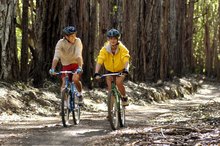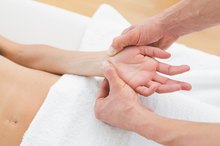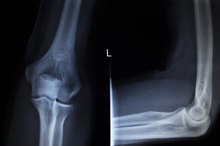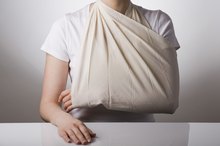Ulnar Nerve Damage From Cycling
Damage to the ulnar nerve, called handlebar palsy, can happen frequently to an avid cyclist according to the Sports Injury Bulletin. This is caused from inflammation of the ulnar nerve. Irritation of this nerve can happen at the elbow or the wrist and is usually due to vibration and shock absorbed by the arms during riding. This condition occurs more commonly in mountain biking and off-road biking. Rest and alterations to the bicycle can help resolve and prevent handlebar palsy from occurring.
If you are experiencing serious medical symptoms, seek emergency treatment immediately.
Anatomy
The ulnar nerve supplies the pinky side or lateral palm, the skin of the lateral two thirds of the hand and the flexor muscles of the anterior forearm. Changes in sensation when the ulnar nerve is affected will occur to the ring and pinky finger. This nerve can be restricted at the wrist or the elbow.
Signs and Symptoms
What Causes Forarm Aches When Cycling?
Learn More
Signs and symptoms vary when handlebar palsy affects the ulnar nerve. At early onset of irritation, the inflammation of the nerve can be felt in the form of tingling or numbness. As the damage to the ulnar nerve continues, pain, weakness and a decrease in grip strength may occur.
- Signs and symptoms vary when handlebar palsy affects the ulnar nerve.
- As the damage to the ulnar nerve continues, pain, weakness and a decrease in grip strength may occur.
Treatment
Rest and ice is the first step in the treatment for ulnar nerve damage. Rest, combined with regular periods of icing, may need to be done for two to four weeks. Splints may also be recommended to avoid further irritation of the nerve. A supplement of B vitamin complex can help heal the nerve damage faster according to the Sports Injury Bulletin. Nonsteroidal anti-inflammatories and steroids can be prescribed by the treating physician. If the condition persists and is not treated, surgery to decrease the pressure on the nerve is a last resort.
- Rest and ice is the first step in the treatment for ulnar nerve damage.
- If the condition persists and is not treated, surgery to decrease the pressure on the nerve is a last resort.
Prevention
Pinched Femoral Nerve Treatments
Learn More
To prevent further irritation of the ulnar nerve, padded gloves will allow bike riding to continue with less aggravation of the nerve. Changing the position of handles and the seat may also help to prevent ulnar nerve damage. If the handlebars are too low or the frame of the bike is too large, you will have to stretch or reach for the handlebars. Also, if the seat is tilted forward, this puts extra weight and pressure on the wrist and forearms.
- To prevent further irritation of the ulnar nerve, padded gloves will allow bike riding to continue with less aggravation of the nerve.
- Changing the position of handles and the seat may also help to prevent ulnar nerve damage.
Related Articles
References
- Human Anatomy; Kent Van De Graaff
- Lee EY, Sebastin SJ, Cheah A, Kumar VP, Lim AYT. Upper Extremity Innervation Patterns and Clinical Implications for Nerve and Tendon Transfer. Plast Reconstr Surg. 2017;140(6):1209-1219. doi:10.1097/PRS.0000000000003873
- Polatsch DB, Melone CP, Beldner S, Incorvaia A. Ulnar nerve anatomy. Hand Clin. 2007;23(3):283-9, v. doi:10.1016/j.hcl.2007.05.001
- Menorca RM, Fussell TS, Elfar JC. Nerve physiology: mechanisms of injury and recovery. Hand Clin. 2013;29(3):317–330. doi:10.1016/j.hcl.2013.04.002
- Cutts S. Cubital tunnel syndrome. Postgrad Med J. 2007;83(975):28–31. doi:10.1136/pgmj.2006.047456
- Colloca L, Ludman T, Bouhassira D, et al. Neuropathic pain. Nat Rev Dis Primers. 2017;3:17002. Published 2017 Feb 16. doi:10.1038/nrdp.2017.2
- Taylor JL, Amann M, Duchateau J, Meeusen R, Rice CL. Neural Contributions to Muscle Fatigue: From the Brain to the Muscle and Back Again. Med Sci Sports Exerc. 2016;48(11):2294–2306. doi:10.1249/MSS.0000000000000923
- Dy CJ, Mackinnon SE. Ulnar neuropathy: evaluation and management. Curr Rev Musculoskelet Med. 2016;9(2):178–184. doi:10.1007/s12178-016-9327-x
- Bonaldo P, Sandri M. Cellular and molecular mechanisms of muscle atrophy. Dis Model Mech. 2013;6(1):25–39. doi:10.1242/dmm.010389
- Lleva JMC. Ulnar Neuropathy. StatPearls [Internet]. Published June 4, 2019.
- Chhabra A, Wadhwa V, Thakkar RS, Carrino JA, Dellon AL. Recurrent ulnar nerve entrapment at the elbow: Correlation of surgical findings and 3-Tesla magnetic resonance neurography. Can J Plast Surg. 2013;21(3):186–189. doi:10.1177/229255031302100305
- Assmus H, Antoniadis G, Bischoff C. Carpal and cubital tunnel and other, rarer nerve compression syndromes. Dtsch Arztebl Int. 2015;112(1-2):14–26. doi:10.3238/arztebl.2015.0014
- Depukat P, Henry BM, Popieluszko P, et al. Anatomical variability and histological structure of the ulnar nerve in the Guyon's canal. Arch Orthop Trauma Surg. 2017;137(2):277–283. doi:10.1007/s00402-016-2616-4
- Ivanov-smolensky AG. [Disordered activity of the nerves in contusion-commotion]. Voen Meditsinskii Sb. 1945;(2):193-8. PMID: 20281202
- Mankowitz SL. Laceration Management. J Emerg Med. 2017;53(3):369-382. doi:10.1016/j.jemermed.2017.05.026
- Institute of Medicine (US) Committee on Pain, Disability, and Chronic Illness Behavior. The Anatomy and Physiology of Pain. Pain and Disability: Clinical, Behavioral, and Public Policy Perspectives. Published January 1, 1987.
- Das Neves Borges P, Vincent TL, Marenzana M. Automated assessment of bone changes in cross-sectional micro-CT studies of murine experimental osteoarthritis. PLoS One. 2017;12(3):e0174294. Published 2017 Mar 23. doi:10.1371/journal.pone.0174294
- Ultrasound. National Institute of Biomedical Imaging and Bioengineering. Published 2019.
- Domkundwar S, Autkar G, Khadilkar SV, Virarkar M. Ultrasound and EMG-NCV study (electromyography and nerve conduction velocity) correlation in diagnosis of nerve pathologies. J Ultrasound. 2017;20(2):111–122. Published 2017 Jan 17. doi:10.1007/s40477-016-0232-3
- Vardeh D, Mannion RJ, Woolf CJ. Toward a Mechanism-Based Approach to Pain Diagnosis. J Pain. 2016;17(9 Suppl):T50–T69. doi:10.1016/j.jpain.2016.03.001
- Grinsell D, Keating CP. Peripheral nerve reconstruction after injury: a review of clinical and experimental therapies. Biomed Res Int. 2014;2014:698256. doi:10.1155/2014/698256
- Kamat AS, Jay SM, Benoiton LA, Correia JA, Woon K. Comparative outcomes of ulnar nerve transposition versus neurolysis in patients with entrapment neuropathy at the cubital tunnel: a 20-year analysis. Acta Neurochir (Wien). 2014;156(1):153-7. doi:10.1007/s00701-013-1962-z
- Woo A, Bakri K, Moran SL. Management of ulnar nerve injuries J Hand Surg Am. 2015 Jan;40(1):173-81. doi:10.1016/j.jhsa.2014.04.038
Writer Bio
Dr. Johnson Chiro is a chiropractor who is excited to share her experience and knowledge about health and wellness with the community. Chiro began writing for her patients and her community newspapers in 2008. She attended Northwestern Health Sciences University where she earned a Doctor of Chiropractic degree. She is licensed to practice in Iowa and Nebraska.









